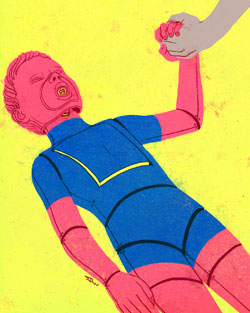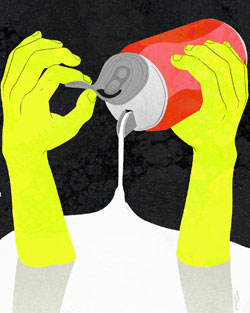SUMMER 2013 CONTENTS
Home
Hiding in plain sight
The environmental factor
Priming the pumps
Debugging Dhaka’s water
Close encounters
How we're crossing paths with disease-bearing pests
Street smarts
Using citizen-scientists to fight for healthier neighborhoods
Beyond hurricane heroics
What Sandy should teach us all about preparedness

DOWNLOAD PRINTABLE
ISSUE (PDF)

TB hideout
Jacob Thomas
Resistance to therapeutic drugs? Check. A free pass from the immune system? Check. A stable living environment? Check.
When it comes to hunkering down, tuberculosis bacteria choose a uniquely qualified lodging site in the body: stem cells in the bone marrow. Here the bacteria nestle, hassle-free, in a dormancy that can last decades before erupting to spread and kill millions of people each year.
Using some of the body’s most precious cells as a hideout? It’s unashamedly devious, undeniably successful and completely unexpected. Stanford postdoctoral scholar Bikul Das, MBBS, PhD, and oncologist Dean Felsher, MD, PhD, were the first to report this wolf-in-stem-cell-clothing tactic in Science Translational Medicine.
“Self-renewing stem cells like these in the bone marrow have properties — such as natural drug resistance, infrequent division and a privileged immune status — that make them resistant to many types of treatment,” says Felsher. “Now it turns out that this ancient organism figured out a long time ago that, for the same reasons, these cells are ideal hosts to invade and in which to hide.”
Das first noticed tuberculosis bacteria in bone marrow biopsies of dormantly infected patients during his years as a physician in India. “We now need to learn how the bacteria find and infect this tiny population of stem cells, and what triggers them to reactivate years or decades after successful treatment of the disease,” he says. —Krista Conger
IUD appeal
Intrauterine devices have been an unpopular form of birth control in developing countries. Negative perceptions and barriers to access mean that just 7.6 percent of women in developing countries use IUDs compared with 14.5 percent in developed ones.
Research from Stanford’s Paul Blumenthal, MD, and Population Services International suggests IUD use can be boosted through better education about — and access to — family planning options. The group detailed in a Contraception paper how this approach helped get IUDs to more than 500,000 women in 13 countries over two years. — Michelle L. Brandt
Tailing stem cells
Repairing damaged hearts by infusing them with stem cells in the hope that these cells will replace worn-out or damaged tissue hasn’t yet met with clinical success. This might partly reflect faulty initial placement, says Sam Gambhir, PhD, MD, professor and chair of radiology and director of the Molecular Imaging Program at Stanford.
“You can use ultrasound to visualize the needle through which you deliver those stem cells. But once they leave the needle, you’ve lost track of them,” he says. Did the cells get to the heart wall? Did they stay there? How long did they stay alive? You don’t know, largely due to a dearth of decent imaging tools.
But Gambhir and his team developed a sensitive visualization technique, described in a study published in Science Translational Medicine, that lets researchers observe in real time where stem cells they’ve injected are going and monitor
them for weeks afterward.
They designed nanoparticles whose chief constituent, silica, is visible to ultrasound. The nanoparticles are doped with gadolinium, an MRI contrast agent. In the study, mesenchymal stem cells — often used in heart-regeneration research because they can differentiate into beating heart cells — gobbled up the nanoparticles without complications and then, infused into healthy mouse hearts, could be viewed immediately afterward with ultrasound and with MRI two weeks later. —Bruce Goldman
Building begins
About 400 administrators, donors and community members gathered May 1 to watch as shiny red shovels were put to ceremonial dirt, marking the formal start of construction of the new Stanford Hospital.
Scheduled to open to patients in 2018, the new building will optimize the hospital’s services and infrastructure, adding beds, private rooms, operating suites, expanded emergency services and the flexibility to adapt to advancing technologies and more streamlined services.
The 824,000-square-foot hospital will increase patient capacity to 600 beds and feature 368 individual patient rooms, an enlarged level-1 trauma center and an emergency department with nearly three times the current capacity.
It’s designed to enhance both physical and emotional healing with the latest in medical, surgical and diagnostic technology. Individual patient rooms will include accommodations for family members to visit and spend the night. A roof garden will create a retreat for patients and families. The building will also incorporate innovations in green technology to reduce the hospital’s environmental impact.
The new hospital is part of the $5 billion Stanford University Medical Center Renewal Project that will bring facilities to current seismic safety standards and support the growth of the medical center. — Ruth Schechter
Self-taught CPR
Jacob Thomas
If a child’s heart stops, quick and skillful CPR can keep oxygen flowing to the child’s brain until paramedics arrive. But in the past, helping parents of high-risk pediatric patients learn CPR in the hospital was challenging.
Now, new research from Lucile Packard Children’s Hospital shows that a self-instructional kit can teach families CPR. The kits, which included a video and mannequin for CPR practice, were distributed in the hospital and taken home for practice after discharge. Six months later, most parents studied were confident in their CPR skills.
“It allowed them to feel relieved that they would know what to do if something ever happened and their child required CPR after they left the hospital,” says resuscitation educator Lynda Knight, RN, who led the study. The findings were published in the Journal for Healthcare Quality. — Erin Digitale
Not so sweet
Jacob Thomas
Does eating sugar cause diabetes? For years, scientists have said “not exactly.” Eating too much of any food, including sugar, can cause weight gain; the resulting obesity predisposes people to diabetes, says the prevailing theory.
But now a large epidemiological study suggests sugar also has a direct link to diabetes. Researchers examined sugar availability and diabetes rates in 175 countries over the past decade. The data the team used did not distinguish between type-1 and type-2 diabetes, though type-2, the form previously associated with obesity, accounts for around 90 percent of cases worldwide. After accounting for obesity and several other factors, increased sugar in a population’s food supply was linked to higher diabetes rates, independent of obesity rates. An extra 12-oz. soda’s worth of sugar per person per day raised diabetes rates by 1 percent. The study was published in PLOS ONE.
“It was quite a surprise,” says lead author Sanjay Basu, MD, PhD, assistant professor of medicine. The study gives the first large-scale evidence that a sugar calorie may be more than just a calorie when it comes to diabetes risk. — Mandy Erickson
Let them eat dirt?
A team led by Mark Davis, PhD, director of Stanford’s Institute for Immunity, Transplantation and Infection, found that over the course of our lives, key immune cells somehow acquire a “memory” of microbes that have never entered our bodies.
So-called CD4 cells hang out in our circulatory system, on the lookout for pathogens that have found their way into the blood or lymph tissue. Our bodies have diverse inventories of these cells, each with its own narrow capacity to recognize a single pathogenic “body part”— or so it’s been thought. If such contact occurs, a CD4 whirrs into a hyperactive state vital to the immune response. CD4 cells fall into two categories:“naïve” cells that randomly target pathogens they haven’t encountered yet, and long-lived “memory” cells that, having had a run-in with a pathogen, are ultra-responsive to it.
In a study published in Immunity, Davis’ team exposed immune-cell-rich blood from 26 healthy adults and from two newborns’ umbilical cords to several nasty viral strains. Nearly all the adult blood samples contained cells responsive to those viruses. More surprising was that about half of the virus-responsive CD4 cells in adult samples were in the “memory” state — even though sensitive tests ruled out participants’ exposure to any of those viruses in real life.
Another surprise: About one-fifth of the samples boasted “cross-reactive” memory CD4 cells responsive to both the nasty viruses and other harmless environmental microbes. This implies that exposure to common bugs in the dirt and in our homes may reduce our susceptibility to dangerous pathogens. — Erin Digitale
Drug searches
After taking a new medication you feel sweaty, so you go online and search for possible side effects. If there were multiple searches for the same information, could they serve as an early alert to previously unreported side effects?
That appears to be the case, based on a study in the Journal of the American Medical Informatics Association. Researchers at the School of Medicine and at Microsoft Research analyzed search histories from Internet users who agreed to share anonymized logs of their Web searches, and pinpointed an interaction between two drugs that was unknown at the time of data collection.
“Patients are telling us lots of things about drugs, and we need to figure out ways to listen,” says co-author Russ Altman, MD, PhD, professor of medicine. — Sarah C.P. Williams


